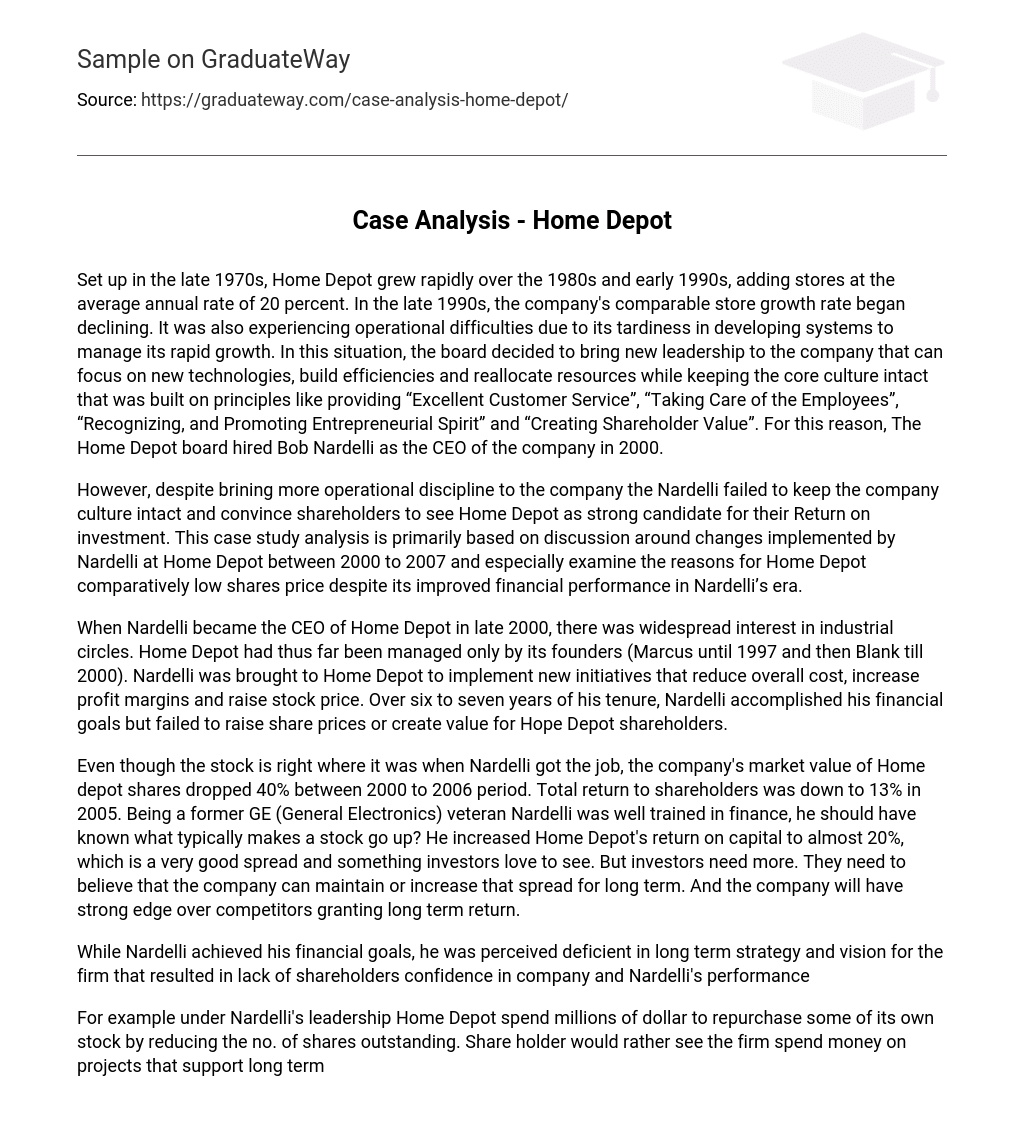Set up in the late 1970s, Home Depot grew rapidly over the 1980s and early 1990s, adding stores at the average annual rate of 20 percent. In the late 1990s, the company’s comparable store growth rate began declining. It was also experiencing operational difficulties due to its tardiness in developing systems to manage its rapid growth. In this situation, the board decided to bring new leadership to the company that can focus on new technologies, build efficiencies and reallocate resources while keeping the core culture intact that was built on principles like providing “Excellent Customer Service”, “Taking Care of the Employees”, “Recognizing, and Promoting Entrepreneurial Spirit” and “Creating Shareholder Value”. For this reason, The Home Depot board hired Bob Nardelli as the CEO of the company in 2000.
However, despite brining more operational discipline to the company the Nardelli failed to keep the company culture intact and convince shareholders to see Home Depot as strong candidate for their Return on investment. This case study analysis is primarily based on discussion around changes implemented by Nardelli at Home Depot between 2000 to 2007 and especially examine the reasons for Home Depot comparatively low shares price despite its improved financial performance in Nardelli’s era.
When Nardelli became the CEO of Home Depot in late 2000, there was widespread interest in industrial circles. Home Depot had thus far been managed only by its founders (Marcus until 1997 and then Blank till 2000). Nardelli was brought to Home Depot to implement new initiatives that reduce overall cost, increase profit margins and raise stock price. Over six to seven years of his tenure, Nardelli accomplished his financial goals but failed to raise share prices or create value for Hope Depot shareholders.
Even though the stock is right where it was when Nardelli got the job, the company’s market value of Home depot shares dropped 40% between 2000 to 2006 period. Total return to shareholders was down to 13% in 2005. Being a former GE (General Electronics) veteran Nardelli was well trained in finance, he should have known what typically makes a stock go up? He increased Home Depot’s return on capital to almost 20%, which is a very good spread and something investors love to see. But investors need more. They need to believe that the company can maintain or increase that spread for long term. And the company will have strong edge over competitors granting long term return.
While Nardelli achieved his financial goals, he was perceived deficient in long term strategy and vision for the firm that resulted in lack of shareholders confidence in company and Nardelli’s performance
For example under Nardelli’s leadership Home Depot spend millions of dollar to repurchase some of its own stock by reducing the no. of shares outstanding. Share holder would rather see the firm spend money on projects that support long term growth and innovation. Stock repurchase is a signal that company executives can’t think of better use for stock holder’s money.
Nardelli also failed to convince shareholders about the company ability to compete effectively against Low’s, its closest competitors. Shareholders believed competitors like Lowe’s, would keep growing and would prevent Home Depot from meeting its target. And they believed that the company would be unable to grow its invested capital; indeed, under Nardelli.
Other than Nardelli’s direct decision there were some other factors that have played an important factor in lack of shareholders confidence. In 2007, downturn in the housing market would have probably the key factor affecting Home Depot market.
Conclusion
To conclude the bottom line is even though Nardelli increased revenues and profits enormously, he failed to fulfil his commitment on creating value for company’s shareholder. He failed to convince investors to believe that they could invest increasing amounts at an attractive return in the future – and the future is what investors buy.





